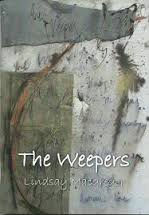The Weepers
 The Weepers by Lindsay Macgregor, is a collection of poems which deals very eloquently with loss. Openly autobiographical if not always obviously confessional, these poems began to form in 2008 after Macgregor’s partner was diagnosed with terminal cancer. A short time after she was bereaved, the poet embarked on a creative writing course at the University of Dundee. Each poem is woven with a blend of rational and folkloric elements, focussing on a remarkable range of topics, from Paleontology to Nordic birds. “The Weepers” poems, placed at intervals, act as the backbone of the collection, recounting a story of the scattering of ashes by the poet and the different versions of herself that lie within. Each holds its own distinguished mood, sometimes with a mix of taut Scots language to draw the reader closer still to the subject. From Merran Gunn’s tersely beautiful cover – dark grey and almost washed away words, the sombre, subtle, yet also challenging, tone is set.
The Weepers by Lindsay Macgregor, is a collection of poems which deals very eloquently with loss. Openly autobiographical if not always obviously confessional, these poems began to form in 2008 after Macgregor’s partner was diagnosed with terminal cancer. A short time after she was bereaved, the poet embarked on a creative writing course at the University of Dundee. Each poem is woven with a blend of rational and folkloric elements, focussing on a remarkable range of topics, from Paleontology to Nordic birds. “The Weepers” poems, placed at intervals, act as the backbone of the collection, recounting a story of the scattering of ashes by the poet and the different versions of herself that lie within. Each holds its own distinguished mood, sometimes with a mix of taut Scots language to draw the reader closer still to the subject. From Merran Gunn’s tersely beautiful cover – dark grey and almost washed away words, the sombre, subtle, yet also challenging, tone is set.
I am particularly fond of “Great Skua”. Initially, the poem suggested a Viking warrior and it was only later that I discovered this great warrior was in fact, a bird. However, this blunder shed an entirely new and parallel light on the poem, comparing the two, tying culture and history to wildlife:
On land you look banished,
in thrall to the heather,
nostalgic for battle
with jarls from the sagas.
Macgregor’s bird looks entirely out of place there, despite being in “thrall” to the land. “Nostalgic” offers an agelessness, and perhaps a wearied pugnaciousness. It has seen the history of the land, and possibly it has seen too much, in its time. In keeping with the theme of loss observed throughout, the image of the bird in flight is sombre indeed:
When you take to the air, it’s sackcloth
and ashes the sail of a longship
bound for Valhalla.
The bird’s flight is compared to that of a Viking longship, however this is far from the elegant representation of the bird that might be expected. Ashes suggests a degree of destruction, be that the ashes of a town, or, more morbidly, the ashes of a person, and indeed of a bitter repentance. Evoking these water-borne funerals, we know this ship is enroute for Valhalla, the Norse underworld. What more haunting, melancholy image of the bird could be painted?
By way of contrast, “Miss Petrie” is a short poem of four three line stanzas. Despite its short nature, its message is layered and dense, thematically in keeping with the whole collection. Buttermilk has something of two sides, both sweet and sour:
On buttermilk Sundays,
thirled to the stoup
of St. Perdita’s kirk […]
While visiting the church on Sunday is supposed to be something religious and holy, undoubtedly these lines portray the reluctant attendee. “Thirled” would suggest that one has been attached, no matter how willing, or unwilling. And further on, this idea of unwillingness is developed:
to ramsons and sorrel,
the floor of the forest
the charcoal the clinker.
The last lines leave a haunting impression, one that fits with the general mood of the collection: “Even buttermilk curdles when cursed” – even the sweetest thing may spoil, much like anything can be lost to us.
I would challenge any reader to gather the full meaning of Macgregor’s allusions and illusions on first, second or even third reading, given the collection’s density and layering. For everyone, there is an entrance, through a portal of soundscape, that captivating and fantastic language, both in English and Scots, and smatterings of Norse. Later, the reader may want to find out more about the mystery of those legends, of the birdlife, the archaeology, or even the overlooked scientist first met in The Weepers. That is perhaps exactly as Macgregor would have wanted. Why should every secret be offered easily?
This is a remarkable, brave and beautiful collection which honours the poet’s inspiration. The reader is privileged indeed.
Rebecca Brown

Leave a Reply